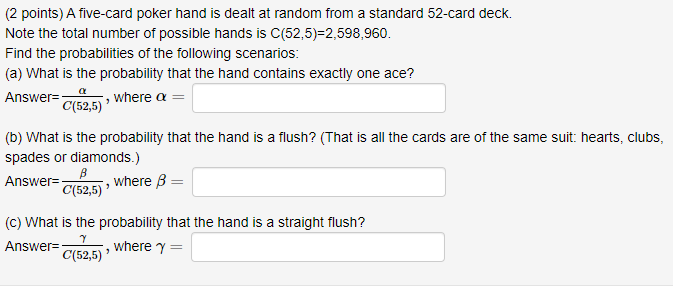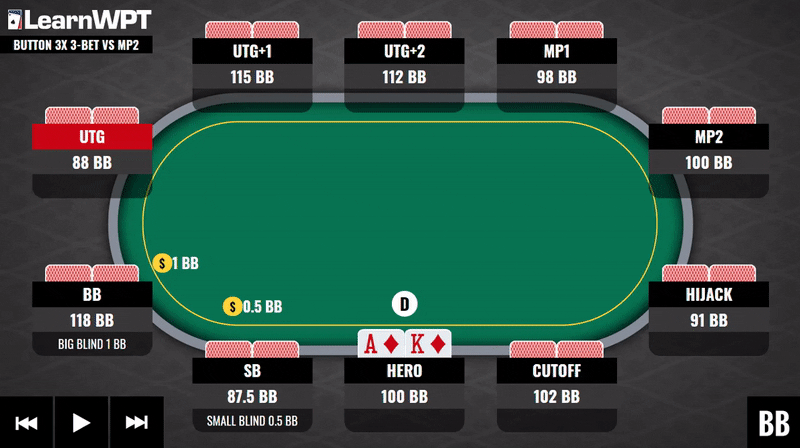Poker Scenarios
Once the flop has been dealt in Texas Hold'em, you'll be able to count your outs and know how likely it is your hand will improve. That will tell you whether you should stay in the hand or fold.
You can figure out your outs and odds for any hand, but here is a quick and dirty list of the most common scenarios:
Poker Equity Chart: Common PREFLOP Scenarios You can never know exactly what an opponent is holding, but this chart helps by matching up hands in common heads-up scenarios. Good poker decisions are good poker decisionsit doesn’t matter if the hand was played online at 10NL or $2/$5 live =) @RiverPrincess May 22, 2016 interesting to see answers which do not reflect mine; My overall impression is I’m either LAG or the respondents are a little nitty.

Texas Hold'em Cheat SheetOdds Based on Outs after the Flop
Poker Scenario Generator


Re: Poker & Poker simulator for learning Advancedpokertraining.com. Is the only place that I am aware that has this. They just had an article in Cardplayer magazine highlighting some new features. A poker odds calculator shows you the exact odds of your hand winning in any scenario. For example, you can give yourself pocket Aces, opponent 1 pocket Kings, and opponent 2 pocket Queens. The poker odds software will then calculate how often each hand wins. GTO solvers are basically a super calculator for poker which allows players to set-up a hand scenario and find the optimal solution to that situation. You basically ask the solver a question and it gives you the GTO answer. Has poker been solved and turned into a game like Tic Tac Toe? There are still limitations to what GTO solvers can do.

Delegation Poker Scenarios
If after the flop, you have:
Two outs: Your odds are 11 to 1 (about 8.5 percent)
A common scenario would be when you have a pair and you are hoping your pair becomes a three-of-a-kind (a set).
Four outs: Your odds are 5 to 1 (about 16.5 percent)
A common scenario would be when you are trying to hit an inside straight draw (there are 4 cards of one number that will complete the straight) or you have two pairs and you hope to make a full house (there are three cards remaining of one number and two of the other).
Eight outs: Your odds are 2 to 1 (about 31 percent)
A common scenario would be that you have an open-ended straight draw. There are four remaining cards of two different numbers that will complete your straight, on the high end and on the low end.
Nine outs: Your odds are 2 to 1 (about 35 percent)
This is the common scenario when you have a flush draw. Any of the nine remaining cards of the suit will give you a flush.
Fifteen outs: Your odds are 1 to 1 (about 54 percent)
A scenario for this is having a straight and flush draw, where either any of the nine remaining cards of the suit will give you a flush, while there are four cards remaining of each of two numbers that would complete a straight. However, you don't count the same cards twice as outs, so those of suit you hope to get don't count again.
The Rule of Four and Two
These odds only apply to counting both the turn and the river, so they assume you will stay in the hand until the showdown. Your odds are only about half as good for a single card draw, such taking the hit on the turn or taking the hit on the river. A common way of looking at the difference in the odds when you will be seeing two cards compared with one is called the Rule of 4 and 2.
Poker Scenarios
After the flop, count your outs and multiply them by four to get your percentage odds. This doesn't give you an exact number, but it is quickly in the ballpark. With 15 outs, 4 x 15 = 55 percent you'll complete that straight or flush with the next two draws.
Poker Scenarios Test
However, when you are calculating the odds that a single draw will improve your hand, you multiply the outs by two rather than 4. With 15 outs, 2 x 15 = 30 percent chance.